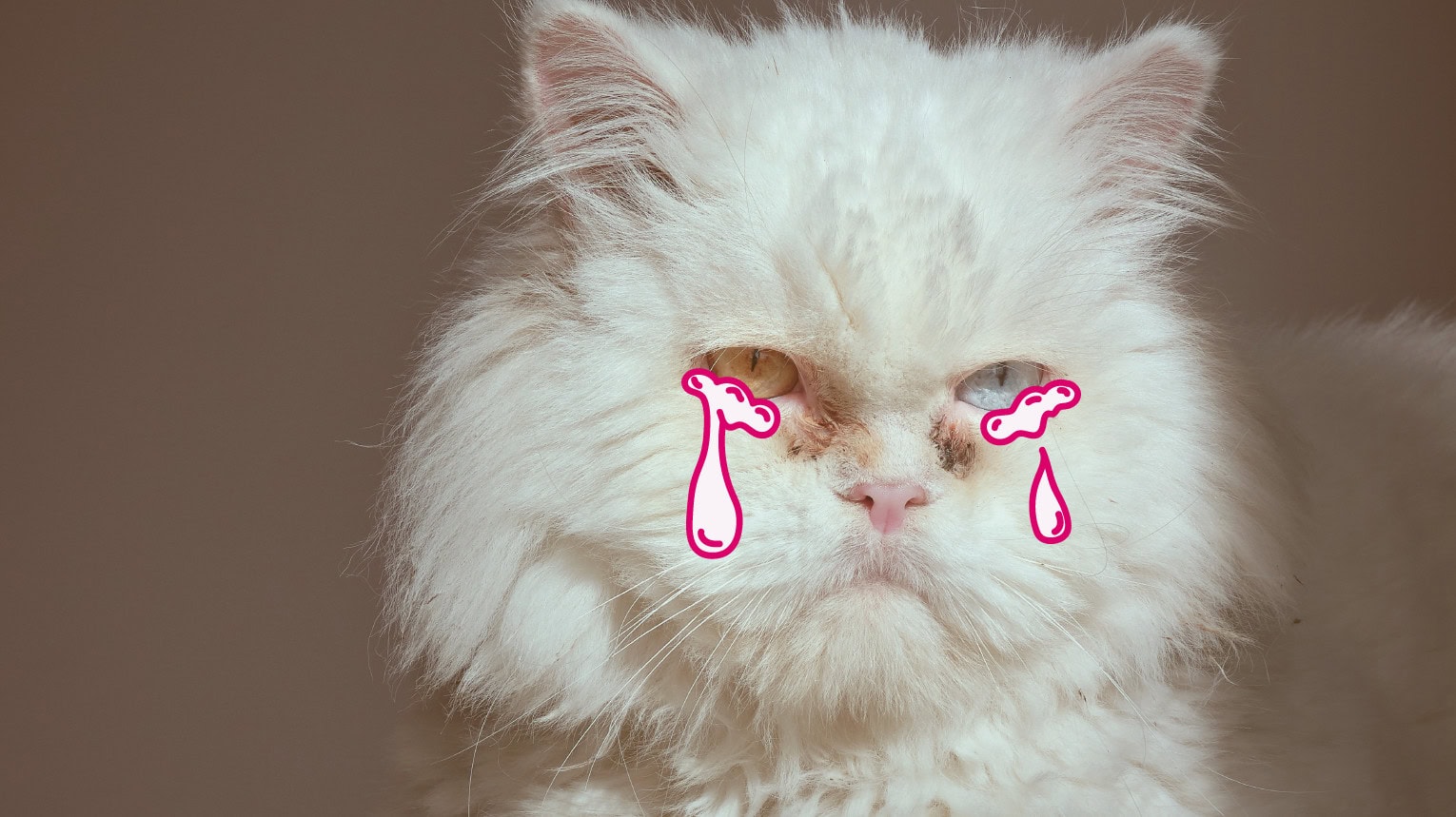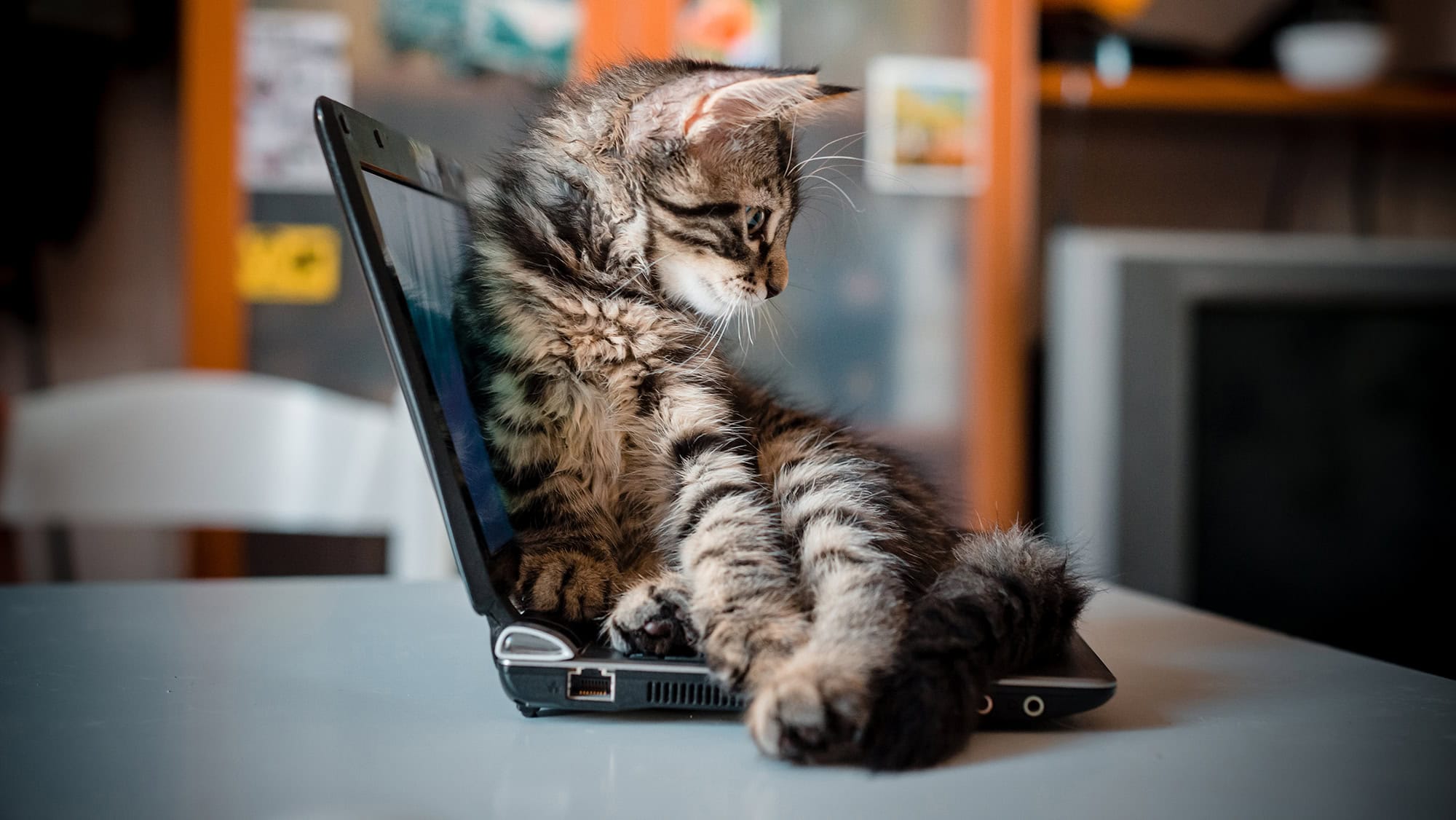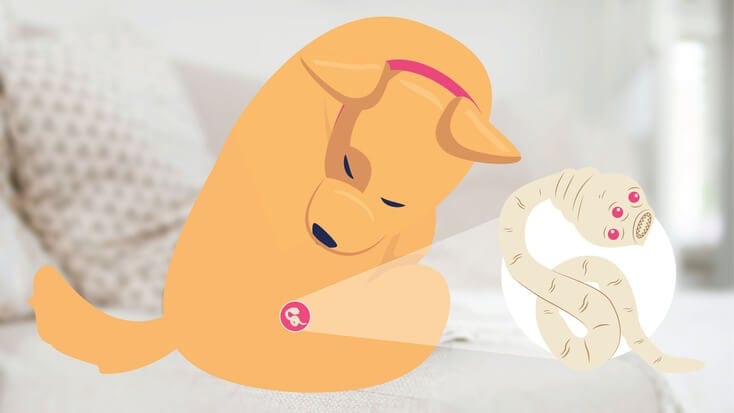Cats can experience various eye problems, ranging from minor irritations to more serious conditions that require veterinary care.
As a mobile veterinarian at BetterVet, I have become very familiar with common feline eye problems, their causes, and symptoms.
In this blog post, I will be providing tips for keeping your cat’s eyes healthy at home and when to seek professional help.
Here’s a complete list of eye problems that cats might experience:
Allergic Conjunctivitis
Allergic conjunctivitis is an eye condition in cats caused by reactions to allergens such as pollen, dust mites, mold spores, smoke, perfumes, and household chemicals, leading to swelling and irritation.
Symptoms of allergic conjunctivitis include:
- Redness in the whites of the eyes and conjunctiva.
- Runny eyes or excessive tearing.
- Squinting and blinking due to irritation.
- Scratching or rubbing at the eyes with their paws.
Treatment focuses on allergen avoidance, eye irrigation with artificial tears or saline, antihistamines to ease itching and inflammation, and possibly prescriptions from a veterinarian for more severe symptoms.
Pink Eye (Conjunctivitis)
Pink eye, or conjunctivitis, involves the redness and swelling of the eye due to various underlying conditions such as viral or bacterial infections, environmental irritants, trauma, immune-mediated diseases, systemic viral diseases, eyelid disorders, dry eye, or parasitic infections.
Symptoms of pink eye in cats include:
- Redness in the whites of the eyes and conjunctiva.
- Runny eyes or excessive tearing, ranging from watery to mucoid discharge.
- Squinting and blinking due to irritation or discomfort, possibly blinking excessively.
- Scratching or rubbing the eyes with their paws.
- Conjunctiva ranging from mild to severe swelling.
- Severely swollen eyes potentially impairing vision.
Treatment focuses on addressing the root cause and alleviating pain, potentially involving antibiotics, topical medications, pain relief prescriptions, immunosuppressive drugs, and tailored veterinary care.
Corneal Damage
Corneal damage occurs when the eye’s clear outer layer, the cornea, is harmed by trauma or negatively affected by irritants. Causes range from eyelid disorders, infections, dry eye, chemical exposure, mechanical injuries, trauma, and foreign objects, to self-inflicted harm from rubbing.
Symptoms of corneal damage in cats include:
- Redness of the sclera and swelling of the conjunctiva.
- Squinting and blinking due to irritation or discomfort, along with light sensitivity.
- Tearing, ranging from watery to mucoid discharge.
- Cloudiness or opacity of the cornea.
- Rubbing or pawing at the eye.
- Impairment of vision.
- Corneal ulceration.
Treatment targets the underlying issue, potentially involving surgery for removal of foreign objects or abnormal growths, infection management, medication to increase tear production, topical therapies, pain relief, and in severe cases, surgical procedures such as corneal grafting or conjunctival flap surgery.
Corneal Ulcers
Corneal ulcers, also known as corneal abrasions or erosions, are localized injuries to the cornea that are intensely painful. They can result from trauma, foreign bodies, infections, dry eye, or eyelid disorders such as entropion or ectropion, and eyelid tumors.
Symptoms or feline corneal ulcers include:
- Redness of the sclera and conjunctival swelling.
- Squinting and blinking due to irritation or discomfort.
- Tearing, ranging from watery to mucoid discharge.
- Cloudiness or opacity of the cornea.
- Rubbing or pawing at the eye.
- Impaired vision.
- Light sensitivity.
Treating corneal ulcers focuses on pain relief, addressing infections, providing lubrication, and preventing further damage with measures like e-collars. In severe cases, surgical interventions like foreign body removal, conjunctival flaps, corneal grafting, debridement, and correcting eyelid disorders may be necessary.
Keratitis
Keratitis is the inflammation of the cornea, the clear front part of the eye, often resulting from infections, traumatic injuries, immune-mediated diseases, environmental irritants, or conformational abnormalities.
Signs of Keratitis in cats include:
- Redness and vascularization on the cornea.
- Squinting, blinking due to irritation, discomfort, and light sensitivity.
- Tearing, ranging from watery to mucoid discharge.
- Cloudiness or opacity of the cornea.
- Rubbing or pawing at the eye.
- Impaired vision.
Treatment aims at the underlying cause, using topical medications like antibiotics or antifungals, lubricating eye drops, pain management, and environmental modifications for allergen control.
Haw’s Syndrome
Haw’s Syndrome is characterized by the elevation of the third eyelid (nictitating membranes) in both eyes of a cat. The exact cause of this condition is unknown, but it is often associated with gastrointestinal disease or other systemic illnesses.
Haw’s Syndrome is typically self-limiting, meaning it usually resolves on its own without the need for treatment.
Horner’s Syndrome
Horner’s Syndrome is a neurological disorder in cats, resulting from a disruption in the sympathetic nerve pathway. This pathway controls certain eye muscles and surrounding structures. Causes can range from trauma, tumors, and inflammation (like infections or middle ear issues) to idiopathic (unknown) origins or vascular disorders affecting nerve blood flow.
Horner’s syndrome symptoms include:
- Ptosis (drooping of the upper eyelid).
- Miosis (constriction of the pupil).
- Enophthalmos (sunken appearance of the eyeball).
- Third eyelid elevation on the same side.
Treatment focuses on identifying and addressing the underlying cause to alleviate the syndrome’s symptoms.
Iris Atrophy
Iris Atrophy involves the degeneration or thinning of the iris, the colored part of the eye, leading to a dull appearance or the illusion of holes in the iris. This condition can result from aging, chronic inflammation (like infections or uveitis), genetics, or glaucoma.
Signs of iris atrophy include:
- “Moth-eaten” appearance of the iris.
- Dull or lightened iris.
- Changes in iris color.
- Irregular pupil size.
- Photosensitivity.
Treatment primarily focuses on managing any underlying cause, monitoring the condition, and making environmental modifications, such as reducing bright light exposure in the cat’s favorite areas.
Epiphora
Epiphora is characterized by excessive tearing from one or both eyes in cats. It can result from blocked tear ducts, breed-specific conformational issues (notably in brachycephalic breeds), chronic inflammation or swelling of the conjunctiva that impedes normal tear drainage, or scar tissue formation.
The primary symptom of Epiphora in cats is the chronic tearing from one or both eyes.
Treating Epiphora typically includes flushing the tear ducts under anesthesia to clear blockages and addressing any underlying conditions causing inflammation.
Glaucoma
Glaucoma in cats is a severe, painful condition characterized by dangerously high intraocular pressures due to excess fluid buildup in the eye, potentially causing irreversible damage and vision loss if untreated. It may occur suddenly or gradually and can affect one or both eyes.
Primary glaucoma, rare in cats, is linked to genetic factors affecting fluid drainage, while secondary glaucoma results from conditions like lens luxation or intraocular tumors disrupting normal eye function.
Symptoms of glaucoma in cats include:
- Sudden blindness.
- Red or cloudy eyes.
- Uneven pupil sizes.
- Bulging of the eyes.
- Excessive tearing.
- Squinting or blinking.
- Avoidance of interaction due to pain.
- Behavioral changes (aggression, increased sleeping).
- Scratching/rubbing at the eyes.
Glaucoma treatment focuses on lowering intraocular pressure, pain relief, preserving vision, and preventing further damage through topical therapies, oral medications, and possibly surgery. Glaucoma often requires lifelong management and regular veterinary monitoring.
Uveitis (Inflammation of the Uveal Tract)
Uveitis involves inflammation of the uveal tract, which includes the iris, ciliary body, and choroid in a cat’s eye, and can result from a variety of causes leading to diverse clinical signs. Causes range from infections (bacterial, viral like herpes, FeLV, FIV, FIP, or Toxoplasma gondii), immune-mediated diseases, trauma, systemic diseases (such as hypertension, diabetes, and cancer), to toxicity.
Signs of uveal tract inflammation include:
- Redness or bloodshot eye(s).
- Squinting due to discomfort.
- Tearing or watering of the eye.
- Photophobia or light sensitivity.
- Hazy eye appearance.
- Change in iris color.
Treatment aims to address the underlying cause, utilizing topical and oral medications to reduce inflammation and manage pain, alongside antibiotics, anti-inflammatories, and immunosuppressive drugs. Supportive care may also involve stress minimization and environmental adjustments for cats with impaired vision.
Entropion
Entropion is a condition where the eyelids roll inward, causing the eyelashes to rub against the cornea, leading to irritation and potential ulcers. This condition can be congenital, often due to genetic predisposition or developmental abnormalities, making breeds like Persians, Burmese, and Himalayans more susceptible.
Acquired entropion may result from trauma, scarring, inflammation, chronic infections, or eyelid tumors.
Symptoms of entropion in cats include:
- Redness of the sclera and swelling of the conjunctiva.
- Squinting and blinking due to irritation or discomfort.
- Tearing, ranging from watery to mucoid discharge.
- Cloudiness or opacity of the cornea.
- Rubbing or pawing at the eye.
- Corneal ulceration.
Treatment focuses on correcting the underlying cause for acquired cases and may involve surgery to correct the eyelid positioning, along with eye lubrication to protect the cornea from further damage.
Retinal Detachment
Retinal detachment is a grave condition in cats where the retina separates from its underlying layer. This can occur in one or both eyes and may lead to sudden blindness. The causes vary and can include hypertension, hyperthyroidism, kidney disease, tumors, vascular disorders like hypertensive retinopathy, trauma, inflammation, and genetic or congenital disorders.
Signs of retinal detachment in cats include:
- Sudden blindness.
- Dilated pupils.
- Abnormal eye movements.
- Changes in eye color (redness or cloudiness).
- Signs of pain (squinting, pawing at the eye).
Treating retinal detachment focuses on addressing any underlying health conditions, but the detachment may be permanent, potentially resulting in blindness. Supportive care, environmental modifications for vision loss, and regular monitoring are crucial components of managing retinal detachment.
Retinal Atrophy
Retinal Atrophy involves the degeneration of the retina, leading to vision impairments such as night blindness and decreased vision. The condition can be primary, often genetic or inherited, or secondary, resulting from underlying health issues like ocular diseases, hypertension, diabetes, uveitis, or retinal detachment, which affect retinal function and blood flow.
Cats with retinal atrophy may experience the following symptoms:
- Night blindness.
- Decreased vision.
- Abnormal pupil sizes (dilated or sluggish responses).
- Abnormal eye movements.
While there’s no cure for retinal atrophy, treatment centers on supportive care to optimize the remaining vision and environmental modifications to accommodate the cat’s visual impairment, such as maintaining consistent furniture placement and providing more lighting at night.
Cataracts
Cataracts in cats are marked by the cloudiness or opacity of the lens, located just behind the pupil, and can potentially lead to blindness. Causes range from natural age-related changes and genetic factors to secondary causes like diabetes mellitus, ocular trauma, and nutritional deficiencies.
Symptoms of cataracts in cats include:
- Cloudy or bluish appearance behind the pupil.
- Decreased vision, potentially leading to blindness.
- Abnormal eye movements or twitching.
- Increased pupil size to enhance light intake.
Treatment for cataracts include surgery for lens replacement, monitoring (as cats often adapt to blindness), and managing any underlying diseases, notably diabetes.
Injuries and Trauma
Injuries and trauma to the eye or head in cats are critical emergencies requiring immediate attention. Causes vary widely, including blunt trauma, penetrating injuries from sharp objects like cat claws, foreign bodies, scratches, chemical burns, and bite wounds.
Signs of injury or trauma to a cat eyes include:
- Swelling of the conjunctiva.
- Hyphema (blood in the eye’s anterior chamber).
- Retinal detachment.
- Lens luxation.
- Pain and discomfort.
- Squinting/excessive blinking.
- Corneal ulcers, abrasions.
- Prolapsed eye globe.
- Blindness.
Treatment focuses on pain management, possibly surgery, and topical and oral medications to treat and prevent infections, along with the use of e-collars to stop the cat from rubbing the injured area.
Masses or Tumors
Cats can develop masses or tumors in or around their eyes, leading to various symptoms such as secondary conjunctivitis, blindness, pain, discomfort, and corneal abrasions or ulcers.
These growths can stem from eyelid tumors causing irritation and corneal ulcers, iris melanoma directly affecting the iris, or squamous cell carcinoma impacting the eyelids, conjunctiva, and third eyelid.
Symptoms of masses or tumors in the eyes of cats include:
- Secondary conjunctivitis.
- Blindness.
- Pain/discomfort.
- Corneal abrasions or ulcers.
Treatment options include surgery to remove the tumor when feasible, supplemented by supportive care like pain management and, in some cases, chemotherapy to address the underlying cancer.
Maintaining Your Cat’s Eye Health: A Summary
Eye problems in cats range from mild irritations to serious conditions that can impact vision and overall health. Recognizing symptoms early—such as redness, swelling, tearing, discomfort, and changes in appearance or behavior—is key to ensuring prompt treatment.
Causes vary widely, including infections, trauma, genetic predispositions, and underlying health issues. Effective treatment hinges on accurate diagnosis and may involve medication, surgery, or supportive care.
Regular veterinary check-ups and attentive care at home are crucial for maintaining your cat’s eye health and catching any issues early. Remember, the well-being of your cat’s eyes is a vital part of their overall health and quality of life.
Frequently Asked Questions
Can ear mites cause eye problems in cats?
Ear mites typically do not cause eye problems in cats but if your cat is scratching or rubbing their ears excessively they can accidentally cause trauma to their eyes or trigger conjunctivitis.
Can fleas cause eye problems in cats?
Excessive scratching or rubbing around the head & eyes can lead to corneal abrasions, secondary infections, or swelling of the eyes.
Can hyperthyroidism in cats cause eye problems?
Yes. Hyperthyroidism if left untreated or uncontrolled can cause retinal detachment & blindness in cats.
What does an infected cat eye look like?
An infected eye may appear red, swollen, be painful, & have clear to green/yellow discharge.
What is an uncommon eye condition in cats?
Cherry eye or prolapsed third eyelid (nictitating membrane) is a relatively uncommon condition compared to dogs although it can occur in cats. This occurs when the third eyelid is persistently elevated in the corner of the eye.
Are certain cat breeds more prone to eye problems?
Certain breeds are more prone to eye problems such as persians, himalayan, burmese, siamese, & sphynx.
Sources:
- Hartley C. Treatment of Corneal Ulcers: When is Surgery Indicated? Journal of Feline Medicine and Surgery. 2010;12(5):398-405. doi:10.1016/j.jfms.2010.03.013
- van den BROEK, A.H.M. (1987), Horner’s syndrome in cats and dogs: a review. Journal of Small Animal Practice, 28: 929-940. https://doi.org/10.1111/j.1748-5827.1987.tb01317.x





